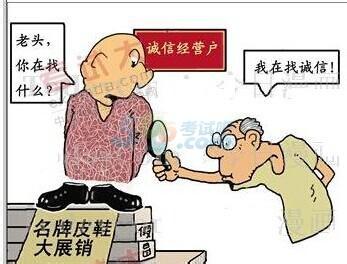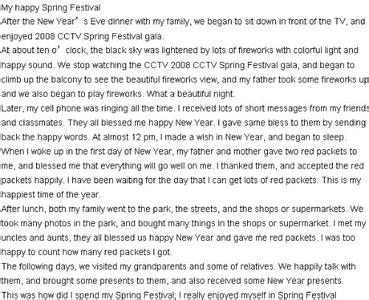篇一:FROM APEC TO WTO
Nowadays, there is a saying going round that China's membership of WTO and successful hosting for Olympic as well as APEC in China this year are China's three active steps in the involvement of the world economical system.
Before China became a member of WTO, APEC has been China's only participation in the international economic organization, and it has always been the important tribune to pass on China's reform and opening information and to promote regional economic co-operations.
In the mean time, China also regards APEC as an important channel and system to connect its economics to the regional and world market, and most of China's policies on reducing tariff were declared in APEC, so in fact China has taken APEC as a preparing school for WTO.
In a word, on behalf of a para- member of WTO, China is there to give an active push to the new negotiation of WTO in Shanghai, and this will surely make an encouraging influence on Dawhah conference in November.
篇二:让APEC蓝持续下去
As is vividly depicted by the drawing above, a boy is sleeping soundly and comfortably in the sofa, with the television on, when his mother comes and turns off the television for him, blaming the boy for not having turned off the television again。
This phenomenon can easily be found anywhere in our daily life. Many people are used to doing everything with the television on, not actually watching it at all. Such a habit can cause waste of much electricity and energy, and result in the emission of carbon. This deviates from the popular concept of “low carbon life” ― to reduce the emission of carbon, especially carbon dioxide, to protect our environment and realize sustainable development. According to statistics, if we can decrease the time for having the television on by one hour each day, we can deduce the amount of carbon emission by 4. 71 kilogram each month。
To serve as responsible stewards of the planet, we must promote and popularize a low carbon life among the public from every detail in our daily life. We must change the past practice of sacrificing long-term environmental health for short-term rapid economic development, and shift to developing green economy, circular economy and low carbon economy. All these effective measures can help us to reach harmony between development of the society and health of the nature。
篇三:APEC BLUE
What is "APEC BLUE"? This is a new word created for the blue sky in Beijing, specially prepared for APEC meetings.
Our government is sparing no effort to ensure cleaner air for APEC meetings.
Beijing has restricted the use of private vehicles based on even and odd license plate numbers. From Nov. 3rd to Nov. 11th, 3am to 12pm, private vehicles with even license plate numbers can only be allowed on even days(4th, 6th etc.), with odd-number vehicles on odd days. Similar rules have been applied to Tianjin municipality, and major cities in Hebei province, the neighbours of Beijing.
Apart from vehicle controls, the government has also announced temporary shutdowns to many factories in Beijing and neighbouring regions to improve the air quality. Moreover, the employees in public institutions and social groups in Beijing, including educational institutions, can also have a holiday from Nov. 7th to 12th, so as to ease congestion during APEC meetings.
Actually, similar policies were introduced during the 2008 Beijing Olympics. However, personally, I am still very surprised by the power of the government in our country.
Good to see the APEC blue sky! However, reducing emissions is, and will always be, a long-term issue and a difficult mission.
Thank you for any comment or correction!
篇四:What do you Know about APEC?|
In January 1989, Australian Prime Minister Hawk raised the proposal of having a ministerial meeting2 on the economic cooperation in the Asia-Pacific region during his visit to Seoul3, Republic of Korea. After talks with relevant4 countries, the first ministerial meeting was held in Canberra,capital of Australia from 6 to 7, November 1989. Foreign Ministers and Economic Ministers from Australia, the United States of America, Canada, Japan, Republic of Korea, New Zealand, Brunei, Indonesia, Malay- sia, Philippines, Singapore and Thailand attended the meeting. Thus Asia-Pacific Economic Cooperation (APEC) was set up. On 20 and 21 November 1993, the first APEC Economic Leaders' Meeting was held in Seattle, the United States of America. Chinese President Jiang Zemin attended this meeting for the first time and he raised the spirit of “mutual respect, mutual benefit, mutual opening and mutual development”.

Members
21 Members include Australia; Brunei; Canada; Chile; People's Republic of China; Hong Kong, China; Indonesia; Japan; Republic of Korea; Mexico; Malaysia; New Zealand; Papua New Guinea; Peru; Philippines; Russia; Singapore; Chinese Taipei; Thailand; United States; Viet Nam.
Objectives5
In November 1991, the 3rd APEC Ministerial Meeting in Seoul issued6 the Seoul APEC Declaration that set the objectives of “interdependence and common interests, to develop and strengthen the open multilateral trading system and reduce regional barriers to trade”.
篇五:有一种蓝叫APEC Blue
so into you, like a Beijing smog.
A clear blue sky in Beijing, a rare sight during the smog season, for the past few days has been waiting to greet delegates to the Asia-Pacific Economic Cooperation meeting. City residents have given it a name: "APEC Blue".
A series of environmentally friendly measures have been taken to reduce the Beijing smog by cutting emissions by 30-40 percent during the APEC meeting, including limiting the number of cars on the road, granting leave to people working in certain types of institutions and suspending production in factories. However, whether these measures will be implemented in the long term remains to be seen.
Perhaps we can learn something from London, where the Great Smog killed 4,000 people in four days in 1952. Britain then passed its first air pollution act, which stipulated that all power plants in London should be shut down, factories must build taller chimneys, and the heating system must be improved. Only with the integrated efforts of multiple sectors can the "APEC Blue" be transformed in a permanent "Beijing Blue".
 爱华网
爱华网



